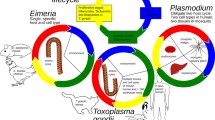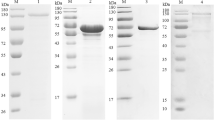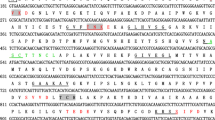Abstract
Chicken coccidiosis is caused by the apicomplexan parasite Eimeria spp. At present, drug resistance of Eimeria is common because of the indiscriminate use of anticoccidial drugs. The gene encoding surface antigen 10 of Eimeria tenella (EtSAG10) is differentially expressed between drug-resistant and drug-sensitive strains. RNA-seq analysis indicated that this gene was downregulated in strains resistant to maduramicin and diclazuril compared to susceptible strains. EtSAG10 DNA sequence alignment revealed that they contained one and ten mutations in MRR and DZR, compared with DS, respectively. A full-length EtSAG10 cDNA was successfully cloned and expressed, and the polyclonal antibody was prepared. The transcription and translation levels of EtSAG10 were analyzed by quantitative real-time PCR (qPCR) and Western blotting. The localization of EtSAG10 in Spz, Mrz, and parasites in the first asexual stage was determined by indirect immunofluorescence. The potential association of EtSAG10 with sporozoite invasion of host cells was assessed by invasion inhibition assays. The results showed that EtSAG10 had a predicted transmembrane domain at the C-terminal end and a predicted signal peptide at the N-terminal end. EtSAG10 was downregulated in drug-resistant strains, which is consistent with the RNA-seq results. The EtSAG10 protein was localized to the parasite surface and parasitophorous vacuole membrane. This protein was shown to play a role in the infection of chicken intestine by sporozoites.





Similar content being viewed by others
References
Antony HA, Pathak V, Parija SC, Ghosh K, Bhattacherjee A (2016) Transcriptomic analysis of chloroquine-sensitive and chloroquine-resistant strains of Plasmodium falciparum: toward malaria diagnostics and therapeutics for global health. Omics 20(7):424–432. https://doi.org/10.1089/omi.2016.0058
Aosai F, Mun HS, Norose K, Chen M, Hata H, Kobayashi M, Kiuchi M, Stauss HJ, Yano A (1999) Protective immunity induced by vaccination with SAG1 gene-transfected cells against Toxoplasma gondii-infection in mice. Microbiol Immunol 43(1):87–91
Belachew EB (2018) Immune response and evasion mechanisms of Plasmodium falciparum parasites. J Immunol Res 2018:6529681. https://doi.org/10.1155/2018/6529681
Ben-Ari Y, Brody Y, Kinor N, Mor A, Tsukamoto T, Spector DL, Singer RH, Shav-Tal Y (2010) The life of an mRNA in space and time. J Cell Sci 123(Pt 10):1761–1774. https://doi.org/10.1242/jcs.062638
Beyer TV, Svezhova NV, Radchenko AI, Sidorenko NV (2002) Parasitophorous vacuole: morphofunctional diversity in different coccidian genera (a short insight into the problem). Cell Biol Int 26(10):861–871
Camara MLM, Canepa GE, Lantos AB, Balouz V, Yu H, Chen X et al (2017) The trypomastigote small surface antigen (TSSA) regulates Trypanosoma cruzi infectivity and differentiation. PLoS Negl Trop Dis 11(8):e0005856. https://doi.org/10.1371/journal.pntd.0005856
Canepa GE, Degese MS, Budu A, Garcia CR, Buscaglia CA (2012) Involvement of TSSA (trypomastigote small surface antigen) in Trypanosoma cruzi invasion of mammalian cells. Biochem J 444(2):211–218. https://doi.org/10.1042/bj20120074
Cardwell MM, Martinez JJ (2009) The Sca2 autotransporter protein from Rickettsia conorii is sufficient to mediate adherence to and invasion of cultured mammalian cells. Infect Immun 77(12):5272–5280. https://doi.org/10.1128/iai.00201-09
Chapman HD (1997) Biochemical, genetic and applied aspects of drug resistance in Eimeria parasites of the fowl. Avian Pathol 26(2):221–244. https://doi.org/10.1080/03079459708419208
Chen T, Zhang W, Wang J, Dong H, Wang M (2008) Eimeria tenella: analysis of differentially expressed genes in the monensin- and maduramicin-resistant lines using cDNA array. Exp Parasitol 119(2):264–271. https://doi.org/10.1016/j.exppara.2008.02.010
Chow YP, Wan KL, Blake DP, Tomley F, Nathan S (2011) Immunogenic Eimeria tenella glycosylphosphatidylinositol-anchored surface antigens (SAGs) induce inflammatory responses in avian macrophages. PLoS One 6(9):e25233. https://doi.org/10.1371/journal.pone.0025233
Doliwa C, Xia D, Escotte-Binet S, Newsham EL, Sanya JS, Aubert D et al (2013) Identification of differentially expressed proteins in sulfadiazine resistant and sensitive strains of Toxoplasma gondii using difference-gel electrophoresis (DIGE). Int J Parasitol Drugs Drug Resist 3:35–44. https://doi.org/10.1016/j.ijpddr.2012.12.002
Entzeroth R, Mattig FR, Werner-Meier R (1998) Structure and function of the parasitophorous vacuole in Eimeria species. Int J Parasitol 28(7):1015–1018
Gazzinelli RT, Denkers EY (2006) Protozoan encounters with toll-like receptor signalling pathways: implications for host parasitism. Nat Rev Immunol 6(12):895–906. https://doi.org/10.1038/nri1978
Geysen J, Ausma J, vanden Bossche H (1991) Simultaneous purification of merozoites and schizonts of Eimeria tenella (Apicomplexa) by Percoll flotation and assessment of cell viability with a double fluorescent dye assay. J Parasitol 77(6):989–993
Gould EN, Corbeil LB, Kania SA, Tolbert MK (2017) Evaluation of surface antigen TF1.17 in feline Tritrichomonas foetus isolates. Vet Parasitol 244:144–153. https://doi.org/10.1016/j.vetpar.2017.08.001
Gregson A, Plowe CV (2005) Mechanisms of resistance of malaria parasites to antifolates. Pharmacol Rev 57(1):117–145. https://doi.org/10.1124/pr.57.1.4
Han HY, Zhao QP, Chen ZG, Huang B (2004) Induction of diclazuril resistant strains and madumycin resistant strains of Eimeria tenella in the laboratory. Chin J Vet Sci 24(2):138–140
Han HY, Lin JJ, Zhao QP, Dong H, Jiang LL, Xu MQ, Zhu SH, Huang B (2010) Identification of differentially expressed genes in early stages of Eimeria tenella by suppression subtractive hybridization and cDNA microarray. J Parasitol 96(1):95–102. https://doi.org/10.1645/GE-2221.1
Han H, Kong C, Dong H, Zhu S, Zhao Q, Zhai Q, Liang S, Li S, Yang S, Huang B (2015) Molecular characterization and functional analysis of subunit 7 of eukaryotic initiation factor 3 from Eimeria tenella. Exp Parasitol 154:118–126. https://doi.org/10.1016/j.exppara.2015.04.002
Huang B, Zhao QP, Wu XZ, Shi TW, Chen ZG (1993) Study on the identification and pathogenicity of the pure species of Eimeria tenella Shanghai. Shanghai J Anim Husb and Vet Med 5:18–20
Jahn D, Matros A, Bakulina AY, Tiedemann J, Schubert U, Giersberg M, Haehnel S, Zoufal K, Mock HP, Kipriyanov SM (2009) Model structure of the immunodominant surface antigen of Eimeria tenella identified as a target for sporozoite-neutralizing monoclonal antibody. Parasitol Res 105(3):655–668. https://doi.org/10.1007/s00436-009-1437-6
Jia PL, Zhao ZM (2017) Impacts of somatic mutations on gene expression: an association perspective. Brief Bioinform 18(3):413–425. https://doi.org/10.1093/bib/bbw037
Jiang LL, Huang B, Han HY, Zhao QP, Dong H, Chen ZG (2005) Comparison of the proteome of the sporutated oocysts of Eimeria tenella diclazuril sensitive strain with diclazuril resistant strain. Chin J Biotech 21(3):435–439
Jiang L, Lin J, Han H, Zhao Q, Dong H, Zhu S, Huang B (2012) Identification and partial characterization of a serine protease inhibitor (serpin) of Eimeria tenella. Parasitol Res 110(2):865–874. https://doi.org/10.1007/s00436-011-2568-0
Kumar D, Singh R, Bhandari V, Kulshrestha A, Negi NS, Salotra P (2012) Biomarkers of antimony resistance: need for expression analysis of multiple genes to distinguish resistance phenotype in clinical isolates of Leishmania donovani. Parasitol Res 111(1):223–230. https://doi.org/10.1007/s00436-012-2823-z
Leal-Sena JA, Dos Santos JL, Dos Santos TAR, de Andrade EM, de Oliveira Mendes TA, Santana JO et al (2018) Toxoplasma gondii antigen SAG2A differentially modulates IL-1beta expression in resistant and susceptible murine peritoneal cells. Appl Microbiol Biotechnol 102(5):2235–2249. https://doi.org/10.1007/s00253-018-8759-1
Lekutis C, Ferguson DJ, Grigg ME, Camps M, Boothroyd JC (2001) Surface antigens of Toxoplasma gondii: variations on a theme. Int J Parasitol 31(12):1285–1292
Leng L, Luo M, Gao J, Shen LJ (2014) Study and application of surface antigen in tachyzoites of Toxoplasma gondii. Chin J Schi Contl 26(6):687–689
Liu Z, Xi D, Kang M, Guo X, Xu B (2012) Molecular cloning and characterization of Hsp27.6: the first reported small heat shock protein from Apis cerana cerana. Cell Stress Chaperones 17(5):539–551. https://doi.org/10.1007/s12192-012-0330-x
Livak KJ, Schmittgen TD (2001) Analysis of relative gene expression data using real-time quantitative PCR and the 2(−delta delta C(T)) method. Med Sci 25(4):402–408. https://doi.org/10.1006/meth.2001.1262
Mbengue A, Bhattacharjee S, Pandharkar T, Liu H, Estiu G, Stahelin RV, Rizk SS, Njimoh DL, Ryan Y, Chotivanich K, Nguon C, Ghorbal M, Lopez-Rubio JJ, Pfrender M, Emrich S, Mohandas N, Dondorp AM, Wiest O, Haldar K (2015) A molecular mechanism of artemisinin resistance in Plasmodium falciparum malaria. Nature. 520(7549):683–687. https://doi.org/10.1038/nature14412
Mollinedo F, Martin-Martin B, Gajate C, Lazo PA (1998) Physiological activation of human neutrophils down-regulates CD53 cell surface antigen. J Leukoc Biol 63(6):699–706
Montero E, Rodriguez M, Gonzalez LM, Lobo CA (2008) Babesia divergens: identification and characterization of BdHSP-20, a small heat shock protein. Exp Parasitol 119(2):238–245. https://doi.org/10.1016/j.exppara.2008.01.020
Peek HW, Landman WJ (2003) Resistance to anticoccidial drugs of Dutch avian Eimeria spp. field isolates originating from 1996, 1999 and 2001. Avian Pathol 32(4):391–401. https://doi.org/10.1080/0307945031000121149
Perez-Morales D, Ostoa-Saloma P, Espinoza B (2009) Trypanosoma cruzi SHSP16: characterization of an alpha-crystallin small heat shock protein. Exp Parasitol 123(2):182–189. https://doi.org/10.1016/j.exppara.2009.06.019
Peroval M, Pery P, Labbe M (2006) The heat shock protein 90 of Eimeria tenella is essential for invasion of host cell and schizont growth. Int J Parasitol 36(10–11):1205–1215. https://doi.org/10.1016/j.ijpara.2006.04.006
Petitdidier E, Pagniez J, Papierok G, Vincendeau P, Lemesre JL, Bras-Goncalves R (2016) Recombinant forms of Leishmania amazonensis excreted/secreted promastigote surface antigen (PSA) induce protective immune responses in dogs. PLoS Negl Trop Dis 10(5):e0004614. https://doi.org/10.1371/journal.pntd.0004614
Qiu BF, Jing J, Dong RL, Song HY, Liu C, Zhu SX et al (2017) Cloning and analysis of SAG10 gene of Eimeria tenella Jiangsu strain. Jiangsu Agric Sci 2017(03):24–28
Reid AJ, Blake DP, Ansari HR, Billington K, Browne HP, Bryant J, Dunn M, Hung SS, Kawahara F, Miranda-Saavedra D, Malas TB, Mourier T, Naghra H, Nair M, Otto TD, Rawlings ND, Rivailler P, Sanchez-Flores A, Sanders M, Subramaniam C, Tay YL, Woo Y, Wu X, Barrell B, Dear PH, Doerig C, Gruber A, Ivens AC, Parkinson J, Rajandream MA, Shirley MW, Wan KL, Berriman M, Tomley FM, Pain A (2014) Genomic analysis of the causative agents of coccidiosis in domestic chickens. Genome Res 24(10):1676–1685. https://doi.org/10.1101/gr.168955.113
Saito F, Hirayasu K, Satoh T, Wang CW, Lusingu J, Arimori T, Shida K, Palacpac NMQ, Itagaki S, Iwanaga S, Takashima E, Tsuboi T, Kohyama M, Suenaga T, Colonna M, Takagi J, Lavstsen T, Horii T, Arase H (2017) Immune evasion of Plasmodium falciparum by RIFIN via inhibitory receptors. Nature. 552(7683):101–105. https://doi.org/10.1038/nature24994
Shirley MW (1995) Eimeria species and strains of chickens. In: Coudert P, Eckert J, Braun R, Shirley MW (eds) Biotechnology – guidelines on techniques in coccidiosis research. The European Commission DGXII, Luxembourg City, pp 9–10
Shirley MW, Smith AL, Tomley FM (2005) The biology of avian Eimeria with an emphasis on their control by vaccination. Adv Parasitol 60:285–330. https://doi.org/10.1016/s0065-308x(05)60005-x
Sun M, Lu MX, Tang XT, Du YZ (2014a) Characterization and expression of genes encoding three small heat shock proteins in Sesamia inferens (Lepidoptera: Noctuidae). Int J Mol Sci 15(12):23196–23211. https://doi.org/10.3390/ijms151223196
Sun H, Wang L, Wang T, Zhang J, Liu Q, Chen P, Chen Z, Wang F, Li H, Xiao Y, Zhao X (2014b) Display of Eimeria tenella EtMic2 protein on the surface of Saccharomyces cerevisiae as a potential oral vaccine against chicken coccidiosis. Vaccine. 32(16):1869–1876. https://doi.org/10.1016/j.vaccine.2014.01.068
Tabares E, Ferguson D, Clark J, Soon PE, Wan KL, Tomley F (2004) Eimeria tenella sporozoites and merozoites differentially express glycosylphosphatidylinositol-anchored variant surface proteins. Mol Biochem Parasitol 135(1):123–132
Thabet A, Honscha W, Daugschies A, Bangoura B (2017) Quantitative proteomic studies in resistance mechanisms of Eimeria tenella against polyether ionophores. Parasitol Res 116(5):1553–1559. https://doi.org/10.1007/s00436-017-5432-z
Tomley F (1997) Techniques for isolation and characterization of apical organelles from Eimeria tenella sporozoites. Med Sci 13(2):171–176. https://doi.org/10.1006/meth.1997.0509
Wang Z, Huang B, Dong H, Zhao Q, Zhu S, Xia W, Xu S, Xie Y, Cui X, Tang M, Men Q, Yang Z, Li C, Zhu X, Han H (2016) Molecular characterization and functional analysis of a novel calcium-dependent protein kinase 4 from Eimeria tenella. PLoS One 11(12):e0168132. https://doi.org/10.1371/journal.pone.0168132
Williams RB (2002) Anticoccidial vaccines for broiler chickens: pathways to success. Avian Pathol 31(4):317–353. https://doi.org/10.1080/03079450220148988
Wilson DW, Goodman CD, Sleebs BE, Weiss GE, de Jong NW, Angrisano F et al (2015) Macrolides rapidly inhibit red blood cell invasion by the human malaria parasite, Plasmodium falciparum. BMC Biol 13:52. https://doi.org/10.1186/s12915-015-0162-0
Yam XY, Preiser PR (2017) Host immune evasion strategies of malaria blood stage parasite. Mol BioSyst 13(12):2498–2508. https://doi.org/10.1039/c7mb00502d
Zhai Q, Huang B, Dong H, Zhao Q, Zhu S, Liang S, Li S, Yang S, Han H (2016) Molecular characterization and immune protection of a new conserved hypothetical protein of Eimeria tenella. PLoS One 11(6):e0157678. https://doi.org/10.1371/journal.pone.0157678
Zhou BH, Wang HW, Wang XY, Zhang LF, Zhang KY, Xue FQ (2010) Eimeria tenella: effects of diclazuril treatment on microneme genes expression in second-generation merozoites and pathological changes of caeca in parasitized chickens. Exp Parasitol 125(3):264–270. https://doi.org/10.1016/j.exppara.2010.01.022
Acknowledgments
We would like to thank all organizations which funded this work and all the teachers who cooperated in technical assistance.
Funding
This work was supported by the National Key Research and Development Program of China (2018YFD0500302), the National Natural Science Foundation of China (Grant No. 31572266, No. 31672551), the National Sharing Service Platform for Parasite Resources (No. TDRC-22), and the Shanghai Minhang District talent development special funds.
Author information
Authors and Affiliations
Corresponding author
Additional information
Section Editor: Xing-Quan Zhu
Publisher’s note
Springer Nature remains neutral with regard to jurisdictional claims in published maps and institutional affiliations.
Electronic supplementary material
Fig. S1
Alignment of EtSAG10 DNA sequences of DS, DZR and MRR. (PNG 135 kb)
Fig. S2
Nucleotide sequence of the full-length cDNA and deduced amino acid sequence of EtSAG10. N-glycosylation site is shown in red. Casein kinase II phosphorylation site is indicated by the wavy underline. A putative N-myristoylation site is underlined. A protein kinase C phosphorylation site is shown in blue. The threonine-rich domain is in a rectangle. (PNG 198 kb)
Rights and permissions
About this article
Cite this article
Liu, G., Zhu, S., Zhao, Q. et al. Molecular characterization of surface antigen 10 of Eimeria tenella. Parasitol Res 118, 2989–2999 (2019). https://doi.org/10.1007/s00436-019-06437-0
Received:
Accepted:
Published:
Issue Date:
DOI: https://doi.org/10.1007/s00436-019-06437-0




